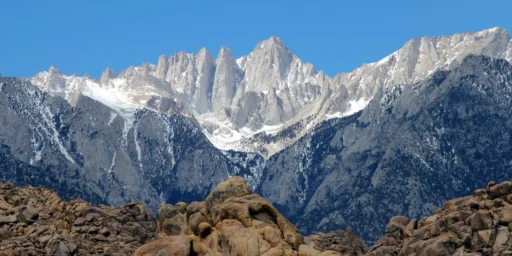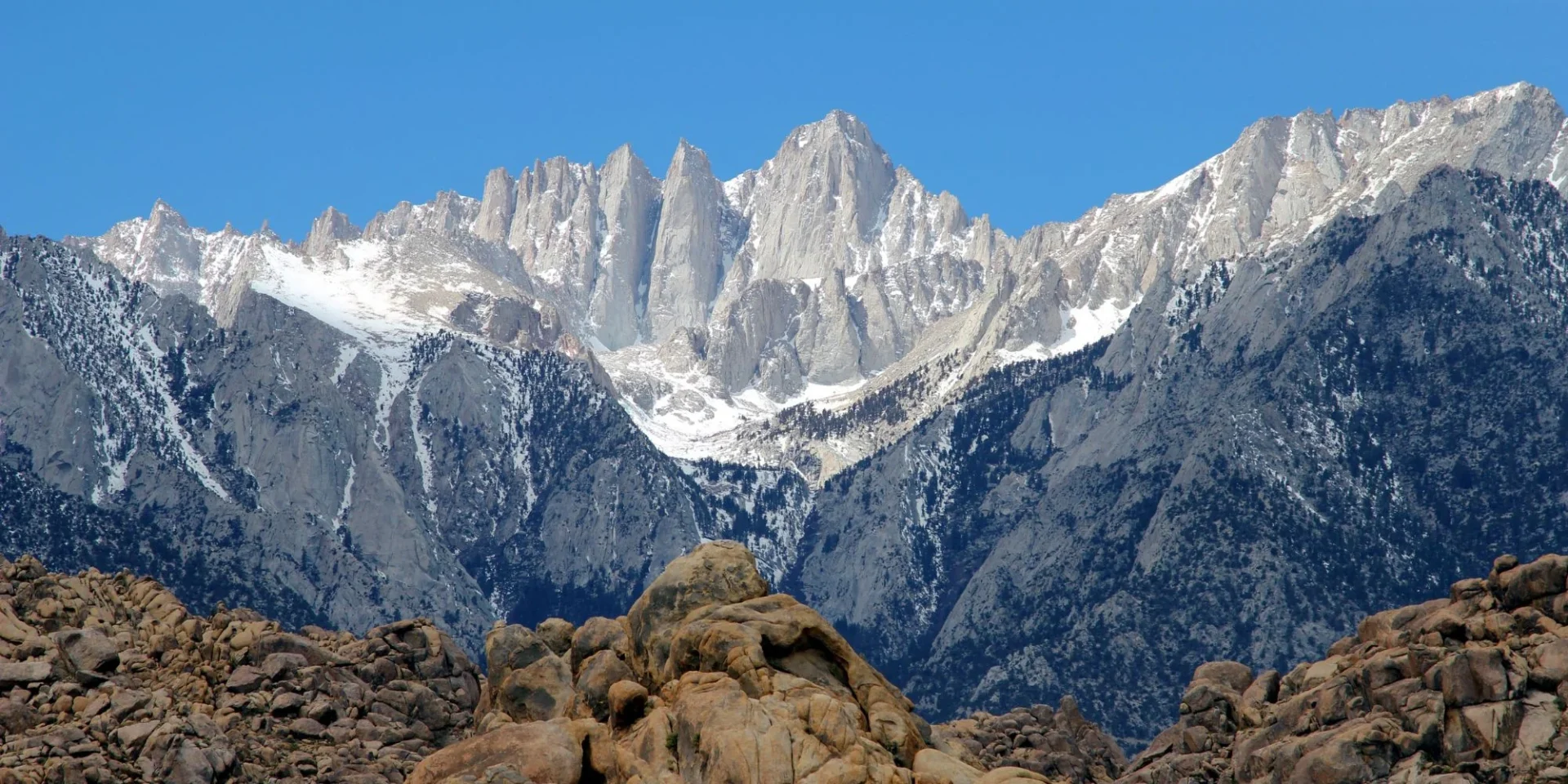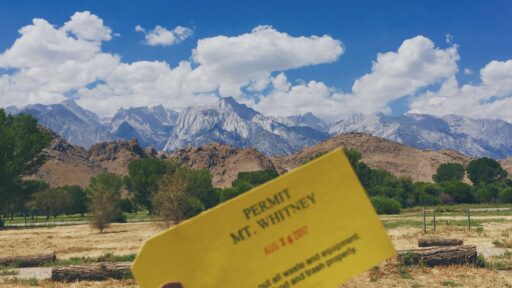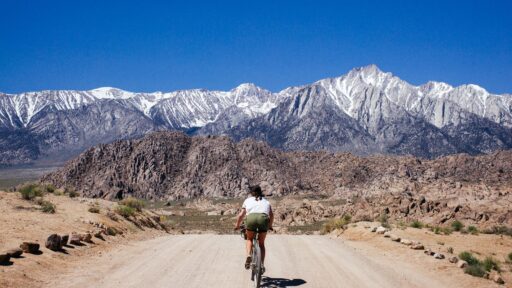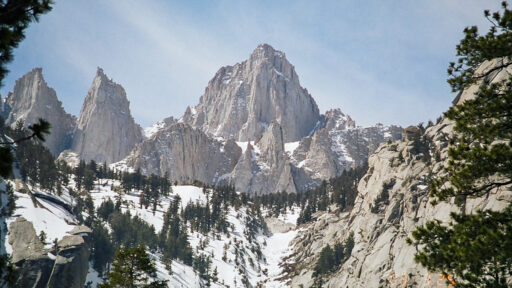Land Acknowledgment: Payahuunadu has been, and continues to be, the homeland of the Paiute (Nuumu), Shoshone (Newe), and Timbisha peoples. This land acknowledgment honors the original inhabitants of the Eastern Sierra and the tribes who remain here today.
Discovering Mount Whitney: The tallest mountain in the Lower 48 states
Towering at 14,505 feet above sea level, Mount Whitney is the tallest peak in the contiguous United States. Nestled in the rugged Sierra Nevada near Lone Pine, California, it’s a destination rich in history, geological intrigue, and outdoor adventure. Whether you’re an avid hiker or a curious traveler, here’s everything you need to know about this iconic landmark.
A Brief History of Mount Whitney
Mount Whitney has long been significant to the indigenous Paiute and Shoshone peoples, who hold deep spiritual and cultural ties to the Sierra Nevada region. In 1864, California’s state geologist, Josiah Whitney, became the mountain’s colonial namesake. However, its importance predates this renaming, as it was part of indigenous traditions and a vital natural resource for centuries.
The first colonial recorded ascent of Mount Whitney occurred in 1873 when three local fishermen—Charles Begole, A.H. Johnson, and John Lucas—reached the summit. They initially named it Fisherman’s Peak, though this name didn’t stick.
By the early 20th century, it was officially recognized as the tallest peak in the lower 48 states, thanks to advancements in surveying and mapping. Its prominence attracted explorers and adventurers from across the country.
The Building of Mount Whitney Portal Road
The Whitney Portal Road, which serves as the gateway to the trailhead, was a community-driven project. Local residents raised funds in the early 20th century to build the road, recognizing its potential to attract visitors and boost the local economy. The road winds up steep mountain slopes, offering breathtaking views of the valley below and leading to Whitney Portal, which now features a store, campground, and parking for hikers.
Trails, Peaks & Passes
The Mount Whitney Trail is a 22-mile round-trip hike, gaining over 6,100 feet in elevation to reach the 14,505 foot summit. This is the most popular route to the summit in an average time of 12 to 16 hours for a day hike.
The Mountaineer’s Route is a shorter route, roughly 12 miles, but technical and favored by experienced climbers and guiding companies.
The John Muir Trail aka the JMT, starts at Mount Whitney trail pass. This iconic trail traverses the Sierra over 211 miles, and ends at Yosemite.
Camping and Permits
Day-use and overnight permits are mandatory for hikers in the Whitney Zone during peak season May 1st through November 1st. You can apply through Recreation.gov. Peak season permits are allocated via a lottery system that opens in February. Visit sayawe.com to learn more about obtaining permits.
You can also car camp at Whitney Portal Campground, You can book campsites as recreation.gov
Fun Facts About Mount Whitney
•The fastest recorded ascent of Mount Whitney is 2 hours, 35 minutes, and 14 seconds, achieved by Jim Walmsley in 2023.
•Mount Whitney, the tallest point in the lower 48 states, is just 85 miles from Badwater Basin in Death Valley, the lowest point in North America.
•The mountain and its surroundings have appeared in classic Westerns and modern films, including Iron Man and Django Unchained.
•The Whitney Portal Store is known for its massive pancakes, killer burgers and fries. Say hi to Doug.
•Mt. Whitney hikers have to abide by a strict “carry it in” and “carry it out” policy. That includes your poop. Yep, all hikers have to carry wag bags on them at all times. A “wag bag” is a resealable plastic bag designed to carry human waste out of wilderness areas and it contains a special gel, called “poo powder, that solidifies the waste and minimizes odor.
•Do you like your car windows? Then don’t leave anything with any odor in your car or the Portal Bears will get you. This gang of bears has zero fear and they break into cars on the regular. Its not good for you or them, so remove everything from your car with a scent.
Note: Please empty the trash from your car in Lone Pine and not at the portal. Otherwise, the forest service or the portal store has to carry everyone’s trash back down the hill and that is a lot of work on a daily basis.
Mount Whitney offers a breathtaking experience steeped in history, natural beauty, and adventure. Whether you’re scaling its summit or simply exploring the trails and views at Whitney Portal, it’s a destination that leaves a lasting impression on all who visit.
A message from AWE
In the ’80s, tossing trash out of car windows was commonplace—until the “Don’t Be a Litterbug” campaign came along and changed behavior on a massive scale. At AWE, we believe the same power of messaging can transform how people care for the places we love to travel and explore. Most people are good, and travel is inevitable—every hike, swimming hole, and climbing spot is just a few clicks away. As content creators, we believe we have a responsibility to weave Leave No Trace principles into everything we share, inspiring travelers to recreate responsibly and minimize their impact on the incredible places so many of us cherish.
Your actions matter: where you walk, how you park, how you treat locals, and even how loud you play your music. It all makes a difference. Search “Leave No Trace” to learn more about responsible recreation and how you can help protect the wild spaces we love and share.
AWE Disclaimer
Recreation activities may involve inherent risks, including but not limited to changing weather conditions, challenging terrain, wildlife encounters, and other unforeseen hazards. Visitors should check with local land management agencies or authorities for up-to-date information on trail conditions, access, permits, and regulations before planning their trip.
Always prioritize safety by being prepared, carrying adequate supplies, and following Leave No Trace principles to protect the environment. Respect local rules, private property, and other visitors. This post is for informational purposes only, and participation in any activity is at your own risk.


